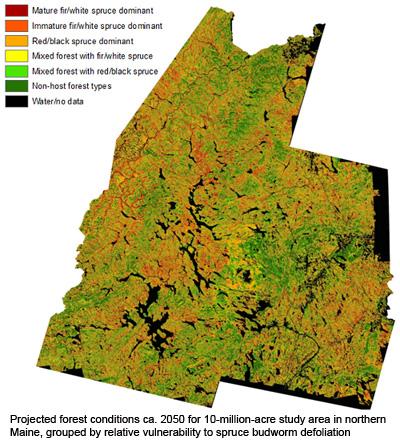Evaluating the Interacting Effects of Forest Management Practices and Periodic Spruce Budworm Infestation on Broad-Scale, Long-Term Forest Productivity

Repeated eastern spruce budworm infestations have profoundly influenced Maine’s spruce-fir forest. This native pest has historically infested the Northern Forest region every 30 to 50 years, causing widespread defoliation, growth reduction, and mortality of balsam fir and spruce trees. The last outbreak resulting in widespread mortality occurred 1972-1986 and motivated extensive salvage harvests, typically commercial clearcuts. As Maine anticipates the next outbreak, these areas are younger, more vigorous, and less vulnerable than they were prior to the last outbreak. However, greater than 2 million acres consist of vulnerable poletimber and sawtimber.
It is critical to develop methods to anticipate and address the challenges presented by large-scale outbreaks coupled with changing forest management practices, ownership, public policy, and market conditions. NSRC researchers used a forest landscape computer model, LANDIS-II (LANDscape Disturbance and Succession), to simulate the coupled dynamics of different forest management scenarios and periodic budworm outbreaks across a 10-million-acre study area in northern Maine to gain better understanding of how harvesting, salvage, and budworm outbreaks interact and influence forest composition and wood supply.
Their 100-year projections show that many areas in northern Maine that did not support balsam fir and spruce in 2010 may transition to more mixed tree species with a significant component of fir and spruce by 2050. Following a budworm outbreak, the combination of budworm-induced mortality and salvage harvest will cause a short-term decline in spruce-fir biomass. Spruce-fir forest will recover in many disturbed areas, but other areas will transition to mixed-softwoods and hardwoods, especially if temperature and precipitation patterns change as a consequence of climate change.
